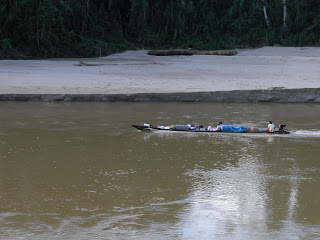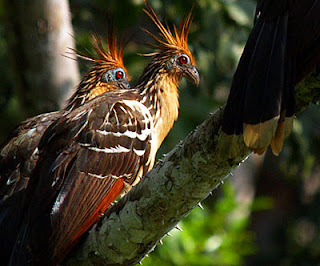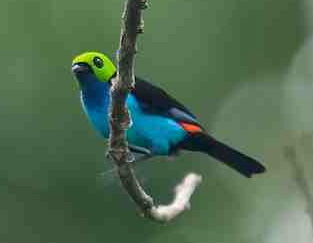One of the main attractions of Peru, indeed the equatorial / near tropic regions is the abundance and diversity of bird life. Peru has over 1800 recorded bird species. North America has 914.
I found the bird spotting exceptionally difficult and photography even more so. The dense jungle, you have experienced. No sooner would you get a near sighting of a bird then it flitted off. Many of the birds are camouflaged either leaf colored or brownish. Trying to see up into poor lighting results in a drab silhouette which defies classifications. My zoom camera chewed up batteries and solar recharging meant that it was limited in its use. It was not possible to have it trigger ready in an instant. Often when I was out, particularly early in the morning, I was working in teams and there was little time to stop and muddle over a bird flicking about in the top of a tree.
But there was still great birding. The major draw for this region are the clay licks, known as colpas. I had learned that colpas were important to the birds and animals of this region as the kaolin in the soil detoxified the alkaloids in the foods they eat. This idea was part of a published study which has since been proven wrong. The soil contains sodium and potassium which many of the plants lack. It is mineral seeking not detoxification.
Part of our daily routine was for two teams to make observations at the Macaw colpa of Red and Green Macaw. The early shift was 6am to about 10am, the late shift 10 to 2. Jose transported two of us across the river and we made a short hike to the blind. Every five minutes observations were made on the Macaw behaviors. We counted each bird we could see and characterized their behavior and position; high in trees, low in the tree-line (shrubbery) or on the lick. Behaviors included preening (self or others) watchful, flying, fighting, playing, eating, walking and sleeping.
There was not a lot of action for the early shift. Early birds were usually the small parrots and parakeets. I particularly liked the bold colors of the Blue-headed Parrot. They were easy to learn and identify. It was a pleasure to be able to watch them without gathering data.
While I never saw them at the colpa, I did have one stunning viewing of Blue and Gold Macaw.
Scarlet Macaws were also in the area, but less frequent at the colpas. Many of the small parrots popular in the cage bird trade are found here.
As the morning moves on the Macaws arrive and displace many of the little parrots. Most of their time is spent on sitting high in the environment preening and watching. They very slowly make their way lower in the trees and, as if by some signal, enter the colpa as a large group.
We kept track of the presence and passing of boats, even noting the type of motor they have, conventional outboard or noisy Peque Peque.
Scientists are working to determine the disturbance of the animals in the environment and the boat traffic is one concern. This is especially true when it comes to eco-tourists and increasing industry of this area of low development. Birds coming overhead would also make the parrots flee. I was surprised to see their reaction to Vultures and have to wonder if this is simply a flee now ask questions later behavior. They returned quickly.
Future work will also look at the bird behavior and to see if the birds make use of a sentinel bird as part of their flock safety. Many mixed flocks here at home will have certain species that are alarm triggers. It will be interesting to see if anything is found out about other species serving as a sentinel as well as same species behavior.
I would have liked to have had more opportunity to go to the Macaw colpa, but there were many duties and rotations to go on and sadly I only visited once. Parrots were all around, however and they were easy to spot due to their noisy flocks.
In the jungle there were several key birds we kept track of and I was lucky to see many Spix Guan.
The classic "heart attack bird" is the White Winged Trumpeter. They would hold quite still until you got very close then they would fly away with a burst of startling sound.
I also had one spotting of a Razor-billed Curassow. These large birds are potential prey for the carnivores of the jungle. They also eat clay.
Birds for birding sake were many and varied. Toucans and Woodpeckers were always fun to spot. I was pleased to see and identify some of the drab antbirds and woodcreepers. At night I could hear owls calling. The Smooth-billed Anis were always skulking around the yard
and on our way home, Jose stopped near shore to allow us a look at the prehistoric looking Hoatzin.
I even spotted a Bluish-fronted Jacamar on an afternoon walk. This is certainly one of the birds I wished to meet.
The capper of all bird sightings came on my last walk in the jungle, the morning we left. Rita, one of our group members, pointed the bird out to me and I was thrilled to see it. Alan said it was the prize for beauty and I agree.
Paradise Tanager. Thank you Dr Rita for your Eagle Eyes!
For me,however, for all the flash and color and amazing qualities, nothing beats my little Paraque. He was my special little bird, the one I saw and never really saw. Paraque are birds of the nightjar (nighthawk) clan. I entered my room one night and my head lamp kicked back a reflective spot across the yard. One bright dot... NOW TWO. Now one , then two. I put my binoculars on it and sure enough I could see a pair of eyes looking back at me. Only two things produce that head swivel, one-eye two-eye effect, owl or nightjar.
I discussed with Alan and he said it would be Paraque. Mr Paraque was there, night after night at the same spot.
I tried many times to get a picture and I can barely believe my luck that I was able to capture something on film.
see the little white dots?
Means the world to me.
I would love to take credit for these photographs but must say most of the bird photos are from Google images. The Ani, Vultures and the Parque are mine.
More than seeing bird is hearing them, night and day. The jungle sounds just as it does in every movie and documentary you see. Rarely do you see the birds that make the sounds but their noise is ever present. The Screeming Pihas started at about 10am every day. They are THE sound of the Amazon lowlands. For such a noisy bird, they are unremarkable, drab, hard to spot.
I was out on a transect walk with Alan when I head this song. The Musician Wren. I got a fleeting glimpse of brown but the song was nothing like the pretty singers here. The clarity , the projection, the ring.
Stunning.
For anyone with a passion for birds I can only recommend David Attenboroughs wonderful "Life of Birds" documentary series. It is on Netflix as instant watch.
I am so thrilled that I was able to experience even a little slice of bird heaven.
Ramblings around Washington State. Natural wonders of my world. I am forever trying to learn. Strong caution, pictures of plants may include bugs,spiders and other "creepy" things. Natural history plants flowers bugs birds biologies. Geology weather conservation and gentle hikes.
About Me
- Upupaepops
- Just a meandering soul sharing my backyard. Visit my Flickr page too! www.flickr.com/photos/meanderingwa/
Saturday, June 25, 2011
Like Here, Only Different ~ Bird Observations
Subscribe to:
Post Comments (Atom)

















Oh my, oh my! I can just see you, head turning from side to side, taking all of this in. You must have been having the time of your life!
ReplyDeleteI wish I could share the direct experience with you. It was beyond my wildest expecttations.
ReplyDelete